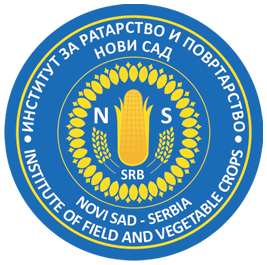Evaluation of experimental maize hybrids tested in multi-location trials using AMMI and GGE biplot analyses
Нема приказа
Аутори
Mitrović, Bojan
Stanisavljević, Dušan

Treskić, Sanja

Stojaković, Milisav
Ivanović, Mile
Bekavac, Goran

Rajković, Miloš

Чланак у часопису (Објављена верзија)

Метаподаци
Приказ свих података о документуАпстракт
Multi-environment yield trials are essential in estimation of genotype by environment (GE) interaction and identification of superior genotypes in the final selection cycles. The objective of this study was to evaluate stability and adaptability of grain yield of experimental maize hybrids by GGE (Genotype and Genotype by Environment Interaction) biplot and AMMI (Additive Main Effects and Multiplicative Interaction) analyses. This study comprised 19 experimental NS (Novi Sad) maize hybrids tested across twelve environments in northern Serbia in a randomized complete block design. The ANOVA (Analysis Of Variance) indicated significant effects of genotypes (G), environments (E) and their interaction (GE). On the same time, the highest percentage of variation was explained by E (77.83%) while G and GE effects together explained the rest of variation ( lt 30%). Joint effects of genotype and interaction (G+GE) was partitioned using GCE biplot analysis where the first two components were sig...nificant, explaining 62.40% (44.34% PC1 and 18.06% PC2) of the GGE sum of squares. The two principal components in AMMI analysis were significant, explaining 53.99% (30.87% PC1 and 23.12% PC2) of interaction variation. Stability of analysed genotypes was similar in both methods. It is concluded that there is no large difference between the AMMI and GGE biplot analyses in evaluation of experimental maize hybrids in different climatic conditions and that both methods can be used equally successfully.
Кључне речи:
breeding / GE interaction / hybrids / grain yield / maize (Zea mays L.)Извор:
Turkish Journal of Field Crops, 2012, 17, 1, 35-40Колекције
Институција/група
FiVeRTY - JOUR AU - Mitrović, Bojan AU - Stanisavljević, Dušan AU - Treskić, Sanja AU - Stojaković, Milisav AU - Ivanović, Mile AU - Bekavac, Goran AU - Rajković, Miloš PY - 2012 UR - http://fiver.ifvcns.rs/handle/123456789/1181 AB - Multi-environment yield trials are essential in estimation of genotype by environment (GE) interaction and identification of superior genotypes in the final selection cycles. The objective of this study was to evaluate stability and adaptability of grain yield of experimental maize hybrids by GGE (Genotype and Genotype by Environment Interaction) biplot and AMMI (Additive Main Effects and Multiplicative Interaction) analyses. This study comprised 19 experimental NS (Novi Sad) maize hybrids tested across twelve environments in northern Serbia in a randomized complete block design. The ANOVA (Analysis Of Variance) indicated significant effects of genotypes (G), environments (E) and their interaction (GE). On the same time, the highest percentage of variation was explained by E (77.83%) while G and GE effects together explained the rest of variation ( lt 30%). Joint effects of genotype and interaction (G+GE) was partitioned using GCE biplot analysis where the first two components were significant, explaining 62.40% (44.34% PC1 and 18.06% PC2) of the GGE sum of squares. The two principal components in AMMI analysis were significant, explaining 53.99% (30.87% PC1 and 23.12% PC2) of interaction variation. Stability of analysed genotypes was similar in both methods. It is concluded that there is no large difference between the AMMI and GGE biplot analyses in evaluation of experimental maize hybrids in different climatic conditions and that both methods can be used equally successfully. T2 - Turkish Journal of Field Crops T1 - Evaluation of experimental maize hybrids tested in multi-location trials using AMMI and GGE biplot analyses EP - 40 IS - 1 SP - 35 VL - 17 UR - https://hdl.handle.net/21.15107/rcub_fiver_1181 ER -
@article{
author = "Mitrović, Bojan and Stanisavljević, Dušan and Treskić, Sanja and Stojaković, Milisav and Ivanović, Mile and Bekavac, Goran and Rajković, Miloš",
year = "2012",
abstract = "Multi-environment yield trials are essential in estimation of genotype by environment (GE) interaction and identification of superior genotypes in the final selection cycles. The objective of this study was to evaluate stability and adaptability of grain yield of experimental maize hybrids by GGE (Genotype and Genotype by Environment Interaction) biplot and AMMI (Additive Main Effects and Multiplicative Interaction) analyses. This study comprised 19 experimental NS (Novi Sad) maize hybrids tested across twelve environments in northern Serbia in a randomized complete block design. The ANOVA (Analysis Of Variance) indicated significant effects of genotypes (G), environments (E) and their interaction (GE). On the same time, the highest percentage of variation was explained by E (77.83%) while G and GE effects together explained the rest of variation ( lt 30%). Joint effects of genotype and interaction (G+GE) was partitioned using GCE biplot analysis where the first two components were significant, explaining 62.40% (44.34% PC1 and 18.06% PC2) of the GGE sum of squares. The two principal components in AMMI analysis were significant, explaining 53.99% (30.87% PC1 and 23.12% PC2) of interaction variation. Stability of analysed genotypes was similar in both methods. It is concluded that there is no large difference between the AMMI and GGE biplot analyses in evaluation of experimental maize hybrids in different climatic conditions and that both methods can be used equally successfully.",
journal = "Turkish Journal of Field Crops",
title = "Evaluation of experimental maize hybrids tested in multi-location trials using AMMI and GGE biplot analyses",
pages = "40-35",
number = "1",
volume = "17",
url = "https://hdl.handle.net/21.15107/rcub_fiver_1181"
}
Mitrović, B., Stanisavljević, D., Treskić, S., Stojaković, M., Ivanović, M., Bekavac, G.,& Rajković, M.. (2012). Evaluation of experimental maize hybrids tested in multi-location trials using AMMI and GGE biplot analyses. in Turkish Journal of Field Crops, 17(1), 35-40. https://hdl.handle.net/21.15107/rcub_fiver_1181
Mitrović B, Stanisavljević D, Treskić S, Stojaković M, Ivanović M, Bekavac G, Rajković M. Evaluation of experimental maize hybrids tested in multi-location trials using AMMI and GGE biplot analyses. in Turkish Journal of Field Crops. 2012;17(1):35-40. https://hdl.handle.net/21.15107/rcub_fiver_1181 .
Mitrović, Bojan, Stanisavljević, Dušan, Treskić, Sanja, Stojaković, Milisav, Ivanović, Mile, Bekavac, Goran, Rajković, Miloš, "Evaluation of experimental maize hybrids tested in multi-location trials using AMMI and GGE biplot analyses" in Turkish Journal of Field Crops, 17, no. 1 (2012):35-40, https://hdl.handle.net/21.15107/rcub_fiver_1181 .

